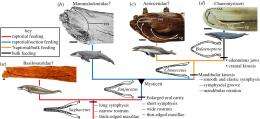August 18, 2011 report
Researcher finds missing link between ancient toothed whales and modern baleen whales

(�鶹��ԺOrg.com) -- Erich Fitzgerald, an Australian paleontologist, believes he has found the missing link between ancient toothed whales that caught and ate fish and modern baleen whales that eat by sucking in huge volumes of water and then filter out the krill and shrimp in it.
In his paper, published in the Royal Society journal, Biology Letters, Fitzgerald describes the skeletal remains of Janjucetus hunderi, named for the beach where the original jaw bone was found; "cetus" Greek, for whale and Staumm Hunder, the youngster who found the fragment. More recently, Fitzgerald discovered that amateur fossil hunter Brian Crichton had more such bones enabling him to build a more complete picture of the ancient (25 million year old) creature.
Fitzgerald suggests that modern baleen whales, a class of whales that use a filter called a baleen to filter food from sea water, evolved from toothed fish eaters to the modern giants we now see, via the Janjucetus, a creature about the size of a contemporary dolphin, but one that had a very different jaw structure.
Baleen whales, a class that include the Blue Whale, the largest animal known to have ever existed, have a jaw that is not fused in front, allowing it to flex and expand so that it can draw in huge amounts of water when lunging at a mass of krill. Ancient whales on the other hand, had jaws very much like dolphins, or even humans for that matter. They opened their mouths and grabbed fish swimming by, using their teeth as mini harpoons, much as Killer Whales do today. Janjucetus falls somewhere in-between; it has a jaw that is fused in front but the upper jaws are inordinately wide, and its snout is short. Also, its mouth is proportionately big for its body.
Fitzgerald theorizes that all of these characteristics put together indicate that Janjucetus captured and ate its prey differently than both its early ancestors and its modern counterpart. Instead of grabbing fish as they came by, Janjucetus sucked in the water surrounding them, pulling them in with it, then chomped down to capture them.
It’s this early sucking, or “hovering” as Fitzgerald describes it, that after several million years, led to the un-fusing of the jaw, the gradual loss of teeth and the appearance of the baleen.
More information: Archaeocete-like jaws in a baleen whale, Biology Letters, Published online before print August 17, 2011,
Abstract
The titanic baleen whales (Cetacea, Mysticeti) have a bizarre skull morphology, including an elastic mandibular symphysis, which permits dynamic oral cavity expansion during bulk feeding. How this key innovation evolved from the sutured symphysis of archaeocetes has remained unclear. Now, mandibles of the Oligocene toothed mysticete Janjucetus hunderi show that basal mysticetes had an archaeocete-like sutured symphysis. This archaic morphology was paired with a wide rostrum typical of later-diverging baleen whales. This demonstrates that increased oral capacity via rostral widening preceded the evolution of mandibular innovations for filter feeding. Thus, the initial evolution of the mysticetes' unique cranial form and huge mouths was perhaps not linked to filtering plankton, but to enhancing suction feeding on individual prey.
© 2011 �鶹��ԺOrg.com

















